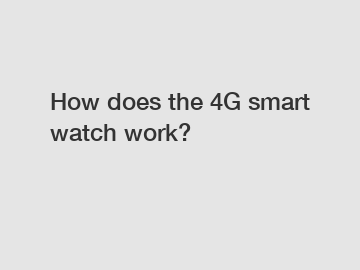How does the 4G smart watch work?
How does the 4G Smart Watch Work?
Overview of 4G Technology.
Before we jump into the world of 4G smartwatches, it is essential to understand the underlying technology that powers these devices. 4G, short for fourth generation, is a standard for wireless communication providing higher speeds and improved data capabilities compared to its predecessors. It enables faster internet browsing, smoother video streaming, and improved overall connectivity. This technology acts as the foundation for 4G smartwatches, allowing them to offer a range of cutting-edge features.

Hardware Components.
A 4G smartwatch combines various hardware components to deliver its functionalities. These components include a processor, memory, display, sensors, and a SIM card slot. The processor acts as the brain of the smartwatch, allowing it to function smoothly and efficiently. The memory stores both the operating system and the user's data, providing quick access whenever required. The display, usually a touchscreen, allows for easy navigation and interaction with the device. Sensors like heart rate monitors, pedometers, and GPS modules enable tracking of health and fitness data as well as location-based services. The SIM card slot, a characteristic feature of 4G smartwatches, allows users to make calls, send messages, and access the internet independently, without the need for a smartphone.
Operating System and Apps.
Similar to smartphones, 4G smartwatches operate on their own operating systems, specifically designed for wearable devices. These operating systems provide a user-friendly interface optimized for the smaller screen size of a smartwatch. Some popular operating systems for smartwatches include WatchOS, Wear OS, and Tizen OS. Additionally, smartwatches support a range of apps that can be downloaded and installed to enhance their functionalities. These apps can include fitness trackers, navigation services, social media platforms, and more, providing a personalized experience to the wearer.
Connectivity and Functionality.
The 4G capability in these smartwatches enables them to work independently from smartphones. They can connect to cellular networks just like smartphones, allowing users to make calls, send messages, and access the internet without needing their phones nearby. Some advanced smartwatches even support e-SIM technology, eliminating the need for a physical SIM card and providing greater convenience. Additionally, 4G smartwatches can be connected to smartphones via Bluetooth, enabling them to receive notifications, control music playback, and monitor health data synced from the phone's apps. This connectivity ensures that the user remains in touch with the world while on the go.
Conclusion.
In conclusion, 4G smartwatches have brought about a new era of wearable technology by combining the functionalities of a traditional watch with the capabilities of a smart device. By leveraging the power of 4G technology, these devices are capable of offering faster connectivity, multimedia streaming, and standalone features such as making calls and sending messages. With their extensive hardware components, dedicated operating systems, and a wide array of apps, 4G smartwatches provide a seamless and convenient experience to users. So whether it's for fitness tracking, staying connected, or simply adding a touch of sophistication to your wrist, a 4G smartwatch is undoubtedly a device worth exploring.
If you have any further questions or require assistance, please do not hesitate to contact us.
If you want to learn more, please visit our website best smartwatch with spo2, spo2 smart band, smart watch manufacture.


